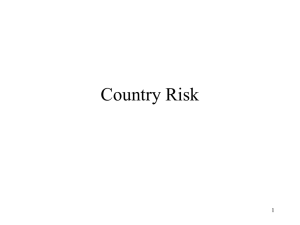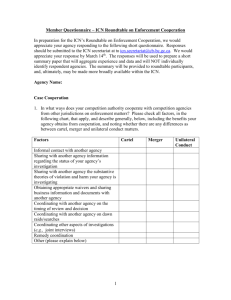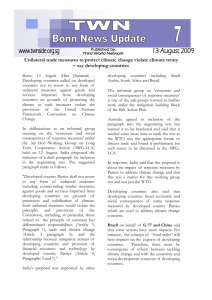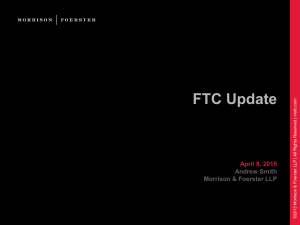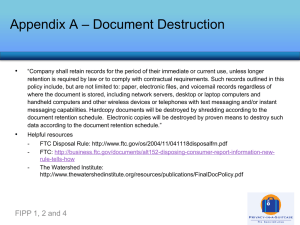Whole Foods' Impact on Unilateral Effects
advertisement
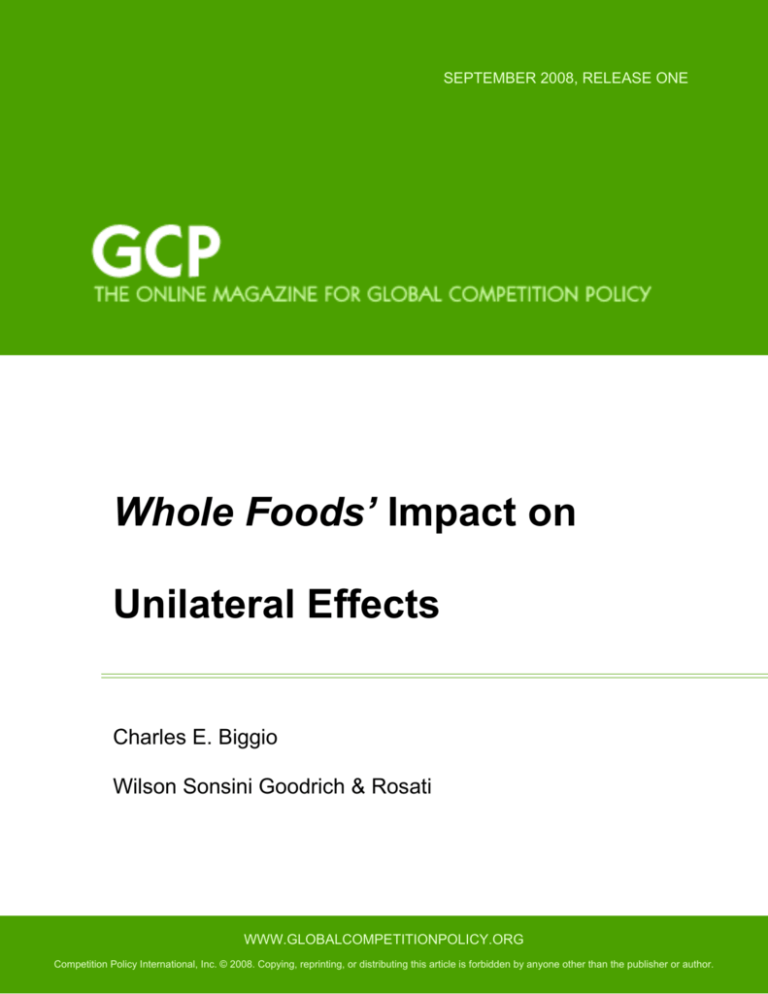
SEPTEMBER 2008, RELEASE ONE Whole Foods’ Impact on Unilateral Effects Charles E. Biggio Wilson Sonsini Goodrich & Rosati WWW.GLOBALCOMPETITIONPOLICY.ORG Competition Policy International, Inc. © 2008. Copying, reprinting, or distributing this article is forbidden by anyone other than the publisher or author. RELEASE: SEP-08 (1) Whole Foods’ Impact on Unilateral Effects Charles E. Biggio∗ he Whole Foods1 case is the most recent installment of the U.S. antitrust authorities’ attempts to persuade courts to rely on unilateral effects principles in ruling against mergers. While efforts have been made in recent years to revitalize “coordinated effects” in merger review, unilateral effects analysis remains the cornerstone of the merger enforcement efforts at the U.S. Department of Justice’s Antitrust Division (“DOJ”) and the Federal Trade Commission (“FTC”). But, despite the emphasis on unilateral effects analysis at the agencies, U.S. courts have been slow to adopt the approach as practiced by the agencies. The district court’s decision in Whole Foods marked yet another defeat. Now comes the decision of the U.S. Court of Appeals for the D.C. Circuit, reversing the district court’s denial of a preliminary injunction. There are many interesting aspects of the D.C. Circuit’s decision, including the FTC’s (now meager?) burden in obtaining a preliminary injunction under § 13(b) of the Federal Trade Commission Act, the role of bad documents and colorful statements against interest made ∗ The author is a partner in the New York office of Wilson Sonsini Goodrich & Rosati, PC, where his practice focuses on antitrust and trade regulation law. He has advised clients on all aspects of antitrust law, including mergers and acquisitions, joint ventures, and intellectual property agreements. In particular, he has extensive experience representing clients in merger and acquisition matters before the U.S. Department of Justice and the Federal Trade Commission. During the Clinton Administration, Mr. Biggio served as acting deputy assistant attorney general for merger enforcement. 1 FTC v. Whole Foods Markets, Inc. , 533 F.3d 869 (D.C. Cir. July 29, 2008). 2 WWW.GLOBALCOMPETITIONPOLICY.ORG Competition Policy International, Inc. © 2008. Copying, reprinting, or distributing this article is forbidden by anyone other than the publisher or author. RELEASE: SEP-08 (1) by a CEO, and the powers of a district court in fashioning a remedy pending further litigation before an FTC administrative law judge. The D.C. Circuit’s decision also has some interesting implications for future unilateral effects cases, though perhaps not entirely in ways envisioned by the agencies. The concept of unilateral effects is simple to describe: In markets characterized by product differentiation, mergers between close competitors are likely to lead to higher prices absent post-merger repositioning of other products in the market and/or efficiencies. In the usual case, the merging firms sell products (A and B) that consumers perceive to be close competitive substitutes for each other. Other products, while perhaps being functional substitutes on some level, are viewed by the consumers of A and B to be substantially differentiated from A and B in terms of product attributes, such that changes in the prices of A or B do not lead consumers to choose other products in significant numbers. After A and B come under common control, the price of A could be raised because many of the consumers of A would switch to B, the profits of which, instead of being lost by the firm selling A, would now be captured by the merged firm. Other consumers would stay with A and pay the higher price, but only a small number would switch to other products. It is the diversion of consumers from A to B, compared to a diversion to any other products, that permits a post-merger price increase. (Note that the same could be said about increases in the price of B leading to significant diversion to A. Post-merger, the prices of both A and B, as well as other products, could increase as a result of how 3 WWW.GLOBALCOMPETITIONPOLICY.ORG Competition Policy International, Inc. © 2008. Copying, reprinting, or distributing this article is forbidden by anyone other than the publisher or author. RELEASE: SEP-08 (1) consumers respond to such increases.) The magnitude of any price increase in any given case would be a function of the cross-elasticities (“diversions ratios”) among the various products in the market (how much of any diverted sales would the merged firm internalize?) and margins (how much would the merged firm make as a result of internalized diversion versus how much would it lose if consumers chose other products?). But, if there is any substitution by consumers between the merging products, some price increase would be predicted by the formulas economists use to measure such effects. If the principles of unilateral competitive effects can be easily articulated, why have courts been reluctant to adopt this approach in ruling against mergers, including the district court in the Whole Foods/Wild Oats merger? A key reason is the tension between case law that focuses on market definition and market share on the one hand, and, on the other hand, the economic principles underlying unilateral effects analysis that can show competitive harm without regard to market definition and market share. Supreme Court precedent, such as United States v. Marine Bancorporation2 instructs judges that Clayton Act § 7 cases are decided by defining the relevant product and geographic market, then calculating market shares, then establishing a presumption of illegality based on undue concentration. But, from an economist’s perspective (and from the perspective of the DOJ and FTC in analyzing mergers), there is no need to define markets and calculate market shares in a unilateral effects case, because the possibility of a post merger price 2 United States v. Marine Bancorporation, 418 U.S. 602, 618 (1974). 4 WWW.GLOBALCOMPETITIONPOLICY.ORG Competition Policy International, Inc. © 2008. Copying, reprinting, or distributing this article is forbidden by anyone other than the publisher or author. RELEASE: SEP-08 (1) increase arises from the combination of close substitutes regardless of the overall dimensions and concentration of the market. This tension between the case law (i.e., market definition) and economic principles (i.e., no market definition) is manifest in virtually every litigated merger case. In each unilateral effects case, the agencies have considered whether to argue that market definition and market share are not necessary elements of a § 7 claim. And in every case, they have chosen not to question the continued vitality of the case law and have made both arguments: (1) the relevant market is narrow and the shares are high and (2) the merging firms are close competitors and the merger would lead to unilateral price increases. However, making both arguments leads to inconsistencies that merging parties have been able to exploit in defeating the agencies’ unilateral effects claims. The inconsistencies arise because the narrow product markets that agencies tend to advance are difficult to prove. While the products of the merging firms may indeed be close substitutes, invariably there is no crystal clear line dividing their products from the products of other competitors, even where there is significant product differentiation in the market. There is always (at least anecdotal) evidence that some purchasers of the merging firms’ products would switch to other products in the face of a small but significant increase in price. If all substitutes, even the more distant ones, are included in the market, it is normally the case that the market shares do not give rise to a competitive concern. In asserting narrow markets, the agencies have been put in a position of having to 5 WWW.GLOBALCOMPETITIONPOLICY.ORG Competition Policy International, Inc. © 2008. Copying, reprinting, or distributing this article is forbidden by anyone other than the publisher or author. RELEASE: SEP-08 (1) explain examples of switching that their theories say should not happen. For example, in United States v. Oracle Corp.3 the DOJ argued for a very narrow product market, which was rejected because the court credited examples of customers who made purchasing decisions that contradicted DOJ’s assertions about what customers would or would not do. In response, the agencies then pivot to their unilateral effects argument—that the examples of switching are not dispositive because market definition is not essential and the number of customers that view the merging firms as close substitutes is substantial enough to demonstrate the likelihood of a post-merger price increase. The problem with making both market definition/market share and unilateral effects arguments is that each argument asks the court to focus on a different question. A market definition argument asks the court to focus on the “marginal” consumers: would consumers switch if a hypothetical monopolist were to raise price? On the other hand, a unilateral effects argument asks the court to focus on the “core” customers: how many consumers would stay with the merged products after the merger? While this distinction may well be more rhetorical than analytical (marginal customers are relevant in analyzing unilateral effects), a district court being asked to define narrow markets and calculate market shares may well perceive a tension in the agencies’ position. No merger case provides the court with perfect information. Rather, courts are asked to rule on mergers based on inferences drawn from incomplete collections of competing facts. If a court is asked by the FTC or DOJ to define a market, but perceives the agency to be overreaching in its market definition, it may well question the credibility 3 United States v. Oracle Corp., 331 F. Supp 2d 1098 (N.D. Cal. 2004) 6 WWW.GLOBALCOMPETITIONPOLICY.ORG Competition Policy International, Inc. © 2008. Copying, reprinting, or distributing this article is forbidden by anyone other than the publisher or author. RELEASE: SEP-08 (1) of the agency’s alternative unilateral effects theory. Indeed, district courts have been unwilling to ignore the evidence of product substitution by customers, and have opted for broad market definitions that have failed to yield high enough market concentrations to sustain a presumption of illegality under the case law. In these cases, the courts in theory could have found harmful unilateral effects notwithstanding low market shares, but they have not done so. The agencies’ unilateral effects analysis has been brushed aside. This pattern continued with the district court’s decision in Whole Foods. The FTC argued that Whole Foods and Wild Oats were each other’s closest competitors. It also advanced a narrow product market definition, “premium and natural organic supermarkets” (PNOS), as distinct from ordinary supermarkets. In the market so defined, the proposed merger would combine the number one and number two firms in several local markets around the country. The FTC submitted evidence, including a report from an eminent economist, detailing how Whole Foods and Wild Oats were sufficiently differentiated from other supermarkets in the eyes of consumers to support its market definition and competitive effects allegations. The parties submitted evidence, including a report from an eminent economist, detailing how the parties considered other supermarkets to be significant competitors and how traditional supermarkets were repositioning themselves to be more natural and organic. The district court concluded that a PNOS relevant product market could not be sustained and that the true market was not concentrated enough to warrant intervention. The FTC appealed, and on July 29, 2008, the D.C. Circuit reversed the district 7 WWW.GLOBALCOMPETITIONPOLICY.ORG Competition Policy International, Inc. © 2008. Copying, reprinting, or distributing this article is forbidden by anyone other than the publisher or author. RELEASE: SEP-08 (1) court’s decision. In ruling for the FTC, the D.C. Circuit decided two things that will make it easier for the agencies to bring unilateral effects cases in the future. First, the D.C. Circuit acknowledged that market definition may not be an essential element in every § 7 case. On appeal, the FTC argued for the first time that market definition is not necessary in a § 7 case. The D.C. Circuit rejected this argument on procedural grounds. The FTC made market definition a key issue below and the district court could not be faulted for following the FTC’s outline of the case. Significantly, however, the D.C. Circuit went on to emphasize that market definition will not “always be crucial to the FTC’s likelihood of success on the merits” and that “the FTC’s chances will not depend, in every case, on a threshold matter of market definition.” This is news. This part of the D.C. Circuit’s decision is the first judicial indication that it may be possible to challenge a merger based on affects without defining a market and calculating market shares. Going forward, the agencies will be able to point to this decision when omitting market definition from their merger challenges where their theory of harm is based on unilateral effects. By omitting market definition from their cases, the agencies may be able to tell their unilateral effects stories more clearly and consistently. The second aspect of the D.C. Circuit’s decision is a bit more complicated as it relates to unilateral effects. With the issue positioned as one of market definition, the D.C. Circuit found error in how the district court determined the relevant market. By assuming that relevant markets are defined by examining the loss of only marginal 8 WWW.GLOBALCOMPETITIONPOLICY.ORG Competition Policy International, Inc. © 2008. Copying, reprinting, or distributing this article is forbidden by anyone other than the publisher or author. RELEASE: SEP-08 (1) customers in response to a price increase, and not core customers, the district court ignored FTC evidence that strongly suggested that Whole Foods and Wild Oats compete for core consumers within a PNOS market, even if they also compete to some extent with other supermarkets for some customers. In summarizing this key issue, the D.C. Circuit stated: …the district court believed the antitrust laws are addressed only to marginal consumers. This was an error of law, because in some situations core consumers, demanding exclusively a particular product or package of products, distinguish a submarket. The FTC described the core PNOS customers, explained how PNOS cater to these customers, and showed these customers provided the bulk of PNOS’s business. The FTC put forward economic evidence—which the district court ignored—showing directly how PNOS discriminate on price between their core and marginal customers, thus treating the former as a distinct market. Therefore, we cannot agree with the district court that the FTC would never be able to prove a PNOS submarket. The problem with the D.C. Circuit’s decision is that it is incorrect regarding the treatment of the role of marginal versus core customers in defining markets. Economists will tell us that the size and behavior of the consumers at the margin will determine whether a product should be included or excluded from the relevant market. The D.C. Circuit is correct in pointing out that the ability of firms to price discriminate may lead to narrower markets focused on “core” (or “inframarginal”) consumers. However, the existence of narrower price discrimination markets requires that firms be able to charge high prices to the core customers while charging low prices to the marginal customers. For this ability to exist, firms would need to identify which customers are marginal and which are not, and to charge each group different prices (without the price difference being eroded through arbitrage). The D.C. Circuit provides no discussion of whether 9 WWW.GLOBALCOMPETITIONPOLICY.ORG Competition Policy International, Inc. © 2008. Copying, reprinting, or distributing this article is forbidden by anyone other than the publisher or author. RELEASE: SEP-08 (1) price discrimination actually exists or how it could be implemented. Thus, the D.C. Circuit’s invocation of a price discrimination markets is misplaced. On the other hand, if the D.C. Circuit’s decision is read as a statement of how district courts should evaluate unilateral effects arguments, its emphasis on core customers is appropriate. From a unilateral effects perspective, the D.C. Circuit could be construed as saying that it was reversible error to reject the FTC’s theory of harm solely on the basis that some consumers may switch to non-PNOS supermarkets in the face of a hypothetical price increase, even if such switching could expand the overall market to include more remotely positioned alternatives. The district court must also evaluate the behavior of the core customers. In other words, the court must also examine the diversion ratios between Whole Foods and Wild Oats before concluding that the FTC is not likely to prevail on the merits of its competitive effects claim. In this way, the D.C. Circuit’s recognition of the role of these “core” customers is a step forward in how courts should evaluate likely unilateral effects. As it stands, the D.C. Circuit’s decision is flawed as it relates to market definition. Its application to unilateral effects is problematic given the posture of the case as an exercise in proper market definition. The parties have petitioned for en banc review of the panel’s decision. Interestingly, one of the arguments made in the parties’ petition is that the court of appeals improperly focused only on market definition and ignored competitive effects. Their position mirrors the FTC’s: market definition is not the end of the analysis, and a merger can be judged lawful or unlawful, regardless of post-merger 10 WWW.GLOBALCOMPETITIONPOLICY.ORG Competition Policy International, Inc. © 2008. Copying, reprinting, or distributing this article is forbidden by anyone other than the publisher or author. RELEASE: SEP-08 (1) market concentration. Perhaps the parties should be careful of what they ask for. One way to clarify the D.C. Circuit’s decision would be to affirm on the basis that the panel was essentially right: core customers must be considered when considering whether a merger will have unilateral anticompetitive effects, even where the overall relevant market may be more broadly defined. 11 WWW.GLOBALCOMPETITIONPOLICY.ORG Competition Policy International, Inc. © 2008. Copying, reprinting, or distributing this article is forbidden by anyone other than the publisher or author.

